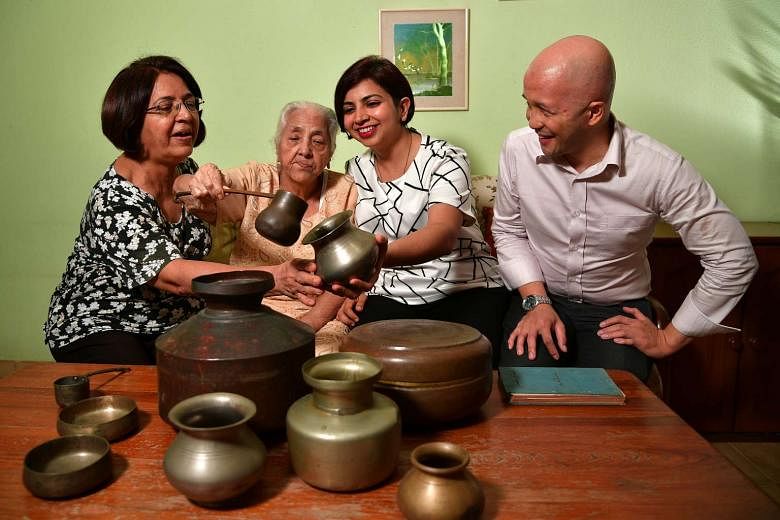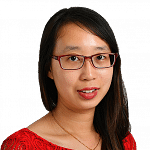Polytechnic lecturer Babita Kotwani, 36, took Malay in primary school and Hindi for her O levels, but neither is her mother tongue.
Ms Kotwani's family speaks Sindhi, a name which comes from the word for the Indus River in South Asia - a cradle of civilisation in the ancient world.
"My dad had a language policy at home. They made us speak only Sindhi, which is probably how we became fluent, " she said.
Using it at home helped to preserve her fluency, as Sindhi is not offered here as a mother tongue language, unlike Tamil, Bengali, Gujarati, Hindi, Punjabi and Urdu.
Sindhi traders began arriving here during the early colonial period, setting up textile businesses and jewellery stores in the High Street area soon after the island's first colonial road was built in 1821.
The Singapore Sindhi Association (SSA) was set up as a merchants' group with 10 members in 1921 . Former president Deepak G. Gurnani, 56, said: "What is a Sindhi? Sindhis are like water. You put us in any container and we assimilate."
But Sindhi migration took place in earnest only after 1947, when the British divided part of South Asia into India and Pakistan. Communal violence ensued, and many Sindhi Hindus fled their province, which had become part of Pakistan.
-
Facts and figures
-
ORIGINS
The Sindhi language originated in the Sindh region, which is now a province of Pakistan. It is also spoken by Sindhis in India and other parts of the world.
Sindh was the heartland of the ancient Indus Valley civilisation, which flourished during the Bronze Age and is believed to be the earliest widespread culture to have sprung up in South Asia.
The Sindhi language can be written in either Devanagari or Arabic script, although the official writing system uses Arabic letters. Owing to its distinctive sounds, such as implosive consonants and various nasal sounds, the Sindhi-Arabic script has 52 letters, compared with Urdu's 35.
A romanised script is also now in use, partly for the ease of attracting younger learners.
NUMBER OF SPEAKERS
The 2010 census counted 3,971 ethnic Sindhi citizens and permanent residents here, but younger people are less likely to be fluent in the language. This is partly because they have the option of taking Hindi, a related language, as their mother tongue in schools.
WHERE TO LEARN IT
Mr Chatru D. Vaswani and Mr Deepak G. Gurnani, who are active in the Singapore Sindhi Association, are willing to teach the language for free to anyone interested.
Classes will meet at the association's headquarters, Sindhu House, in Mountbatten Road.
Call Mr Vaswani on 6338-3928 or Mr Gurnani on 9145-0544.
FOOD
• Pakora: Deep-fried vegetable fritters with spices
• Gobi patata (cauliflower and potatoes): A Sindhi take on what in Hindi and Urdu is called aloo gobi
• Sai bhaji: A lentil and spinach stew
• Bhindi basar: Fried ladies' fingers with onions and tomatoes
-
Annabeth Leow
Said Mr Gurnani, a businessman: "Do the Sindhis mourn the loss of their language? Yes and no. We lost our land, but when you have lost your land, the whole world can be called your home. That is our gain. We are truly global citizens."
Mr Raj Thakurdas, 67, a textile merchant, said: "The only thing that differs between Sindhis in Singapore (and elsewhere) is accent."
The third-generation Singaporean, whose grandfather came here in 1927, is in charge of the SSA's prayer hall and helps out at festivals such as Cheti Chand, the Sindhi new year, which fell on March 29 this year.
Retiree Chatru D. Vaswani said: "When you have a country of your own, the language and culture survive, but because we have been dispersed, my children grew up in a culture with Malays, Chinese and south Indians."
Mr Vaswani, 86, who has lived here since 1953, is also active in the SSA. He and other older Sindhis still gather in the High Street area to speak Sindhi with one another.
"(Younger Sindhis) might speak a bit of broken Sindhi at home, but in workplaces and schools, the use of the language is diluted," he said.
Ms Kotwani and her siblings are indeed rare among their generation. Her husband, a fellow Sindhi, can follow conversations and use words like "bas" (enough) when food is being dished out onto his plate - but that is the extent of his fluency, making conversation with Sindhi-speaking elders somewhat one-sided.
Like Malay, Sindhi has roots in both Sanskrit and Arabic. It can be written in both the Devanagari script, like Hindi, and the Arabic script, like Urdu.
The woman who Ms Kotwani calls "nani" (maternal grandmother) is Madam Mohini Kalwani, 87, a housewife who settled in Singapore in the late 1950s. Today, she speaks mostly Sindhi, alongside the Malay that she picked up here.
One of her prized possessions is a kitaab, or book, called Isteri Sansar (The World Of Women). Her recipe collection, which dates to the mid-20th century, is printed from right to left in Arabic script.
Ms Kotwani's cousin, literature teacher Laremy Lee, 34, said: "I'm most fluent in English. When it comes to Sindhi, my sister understands complex sentences but I can understand only things like 'Do you want to eat?'"
Sindhi is notoriously hard to learn, he said.
Part of the difficulty is the existence of certain unusual sounds.
Said Ms Kotwani: "Most consonants tend to be plosives. But certain sounds in Sindhi are implosive, which means you take air in, when making the sounds." She has a master's degree in linguistics and wrote her bachelor's thesis on the morphosyntax of Sindhi grammar.
Examples of tricky words include "ddh", or "yogurt". The initial "d" is implosive, which makes the word sound a little like "du-dh".
Still, the language barrier did not stop Mr Lee, who is both Sindhi and Teochew, from embarking on a family oral history project in 2015. He has been collecting stories from his aunts and grandmother, with an eye to writing an English-language novel or a play about a Sindhi family.
"My aunts were a bit sceptical about this, until they started reliving the nostalgia," said Mr Lee.
Ms Kotwani's mother, assistant childcare teacher Shanta Kotwani, 66, was one of the aunts won over by Mr Lee's interest in her childhood memories.
She said: "I never saw the importance of knowing your own language, but my husband did, so now I feel good that I can speak the language. There're a lot of things that we can learn - like when we speak Malay, we can see the similarities."
Ms Kotwani, who got who married recently, said fondly: "It's the language you get scolded in and the language you get loved in. It has a lot of emotional significance. I'd like to be able to scold my children in Sindhi."



